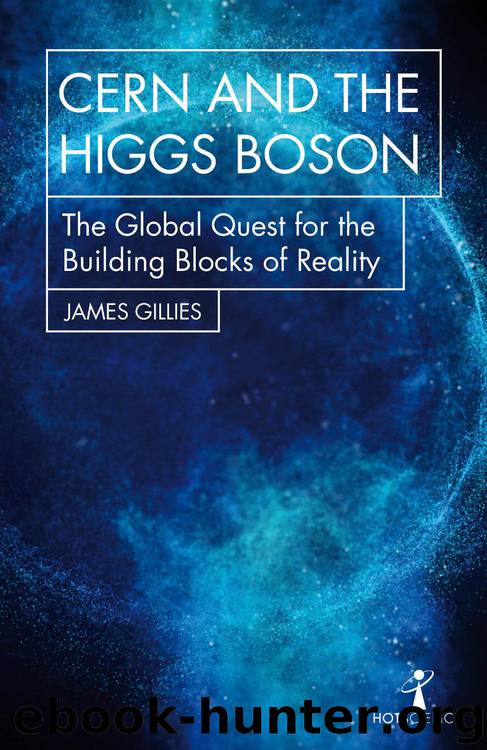CERN and the Higgs Boson by James Gillies

Author:James Gillies [James Gillies]
Language: eng
Format: epub
ISBN: 9781785783937
Publisher: Icon Books Ltd
Published: 2018-11-01T16:00:00+00:00
Keeping cool
Perhaps the most important technique to be tested at the ISR was invented by an unassuming Dutch engineer who had joined CERN in 1956 to work on power converters – devices that take power from the mains and convert it to the form needed to run particle accelerators. In this he was second to none, but Simon van der Meer was also a man who loved puzzles, and he was someone who had the intellect and patience to solve the most complex ones. He would never use two words where one would suffice. But that one word would invariably be the right one, as he demonstrated week after week by completing the Observer crossword, despite not being a native English speaker. Puzzle solving was a talent that served him, and particle physics, well.
One of the biggest puzzles in 1970s accelerator physics was how best to marshal loose crowds of particles into dense bunches that could be used for physics: a process known as cooling. This would prove to be vital in machines that collided protons with their antimatter counterparts, antiprotons. Unlike protons, which can be extracted relatively simply from hydrogen, antiprotons have to be made by smashing a proton beam into a target and filtering off the small number of antiprotons that are produced. It’s a slow and painstaking process, and the antiprotons are produced with a wide range of momenta. Cooling is the process that tames them, allowing intense beams of antiprotons to be accumulated.
Simon van der Meer first addressed the question of cooling at a meeting in 1968. He devised a technique that essentially involved two components: a detector that would measure the motion of particles at one point on the ring, and a device that would ‘kick’, or marshal, beam particles into line at another point on the ring. When the beam passed the detector, it would measure the deviation of a sample of particles with respect to the correct orbit and then send a signal across the ring to the kicker device allowing it to nudge the beam. He called the idea stochastic cooling, stochastic meaning random, since on each orbit a random sample of particles is measured to provide the correction. The technique does not correct the deviation of all the particles at once, but over time each particle is nudged towards the chosen orbit and a once unruly crowd becomes a tightly marshalled beam.
It was to be some time, however, before van der Meer’s stroke of genius became reality. As with many a puzzle solver, once one puzzle was solved, he would move on to the next one and his colleagues sometimes had a devil of a time convincing him to write up his ideas. But write them up he did, putting pen to paper in 1972. In a footnote, he wrote: ‘This work was done in 1968. The idea seemed too far-fetched at the time to justify publication.’ Soon after, his doubts were put to rest when stochastic cooling was successfully tested at the ISR.
Download
This site does not store any files on its server. We only index and link to content provided by other sites. Please contact the content providers to delete copyright contents if any and email us, we'll remove relevant links or contents immediately.
The Complete Stick Figure Physics Tutorials by Allen Sarah(7135)
Secrets of Antigravity Propulsion: Tesla, UFOs, and Classified Aerospace Technology by Ph.D. Paul A. Laviolette(4974)
Thing Explainer by Randall Munroe(3782)
The River of Consciousness by Oliver Sacks(3412)
The Order of Time by Carlo Rovelli(3072)
How To by Randall Munroe(2911)
I Live in the Future & Here's How It Works by Nick Bilton(2839)
A Brief History of Time by Stephen Hawking(2819)
What If?: Serious Scientific Answers to Absurd Hypothetical Questions by Randall Munroe(2542)
The Great Unknown by Marcus du Sautoy(2532)
Midnight in Chernobyl by Adam Higginbotham(2384)
Blockchain: Ultimate Step By Step Guide To Understanding Blockchain Technology, Bitcoin Creation, and the future of Money (Novice to Expert) by Keizer Söze(2379)
Networks: An Introduction by Newman Mark(2264)
The Meaning of it All by Richard Feynman(2213)
Easy Electronics by Charles Platt(2204)
The Tao of Physics by Fritjof Capra(2162)
Midnight in Chernobyl: The Untold Story of the World's Greatest Nuclear Disaster by Adam Higginbotham(2074)
When by Daniel H Pink(2020)
Introducing Relativity by Bruce Bassett(2015)
